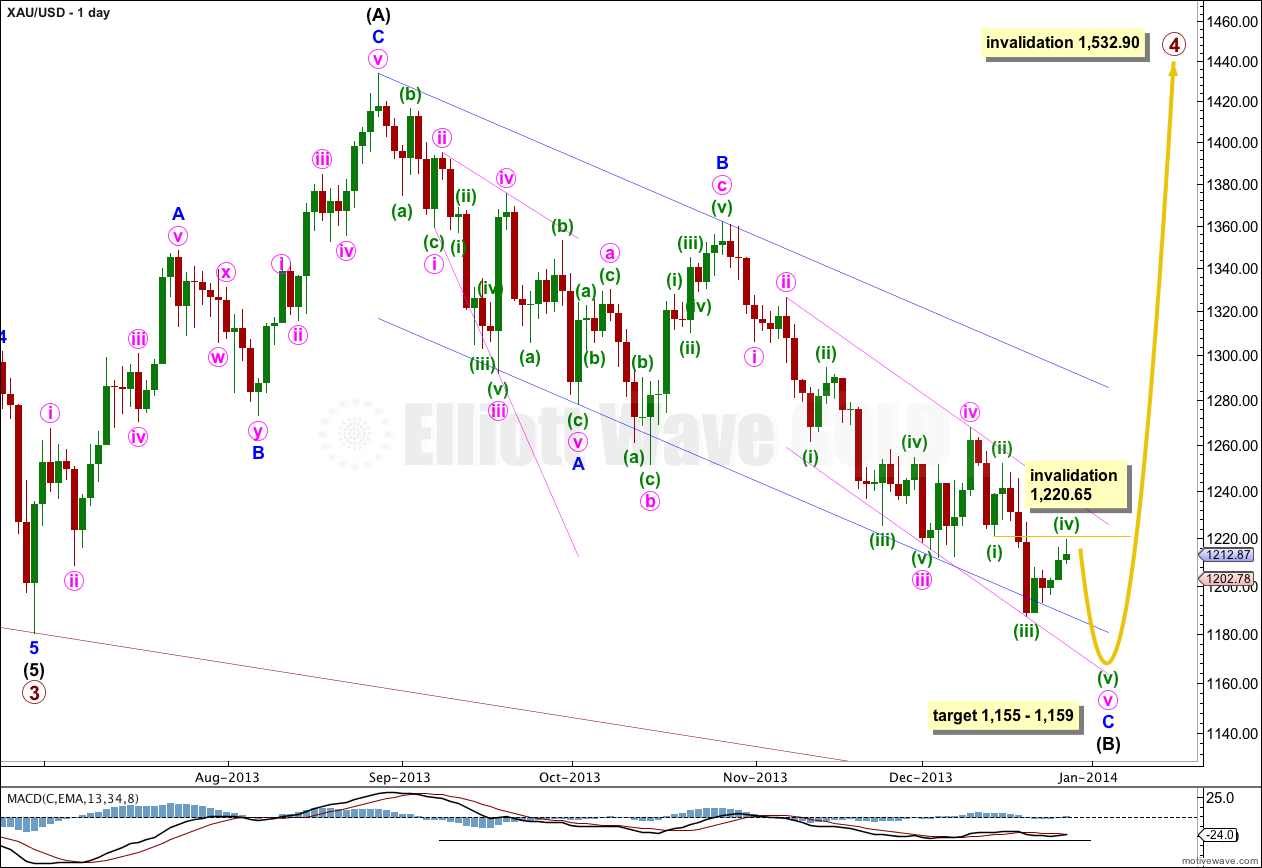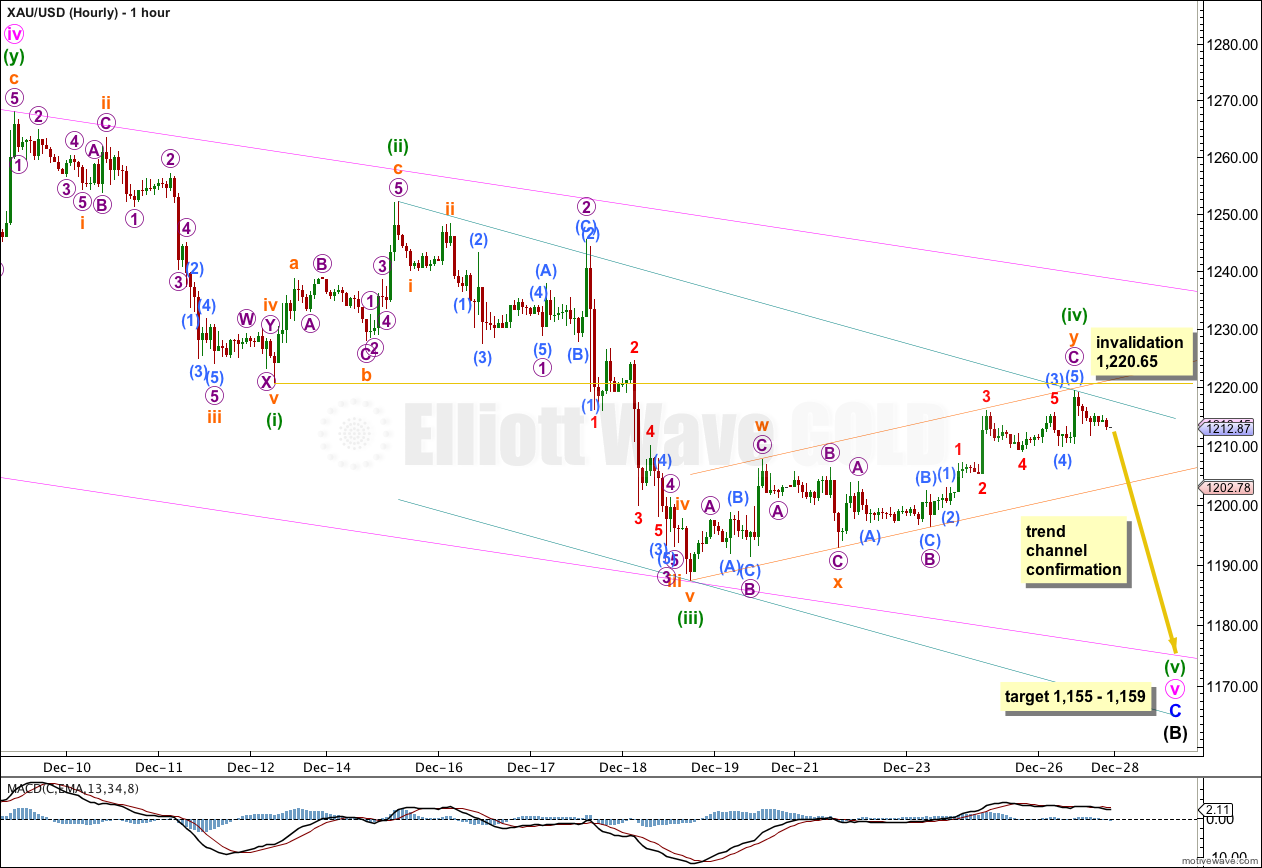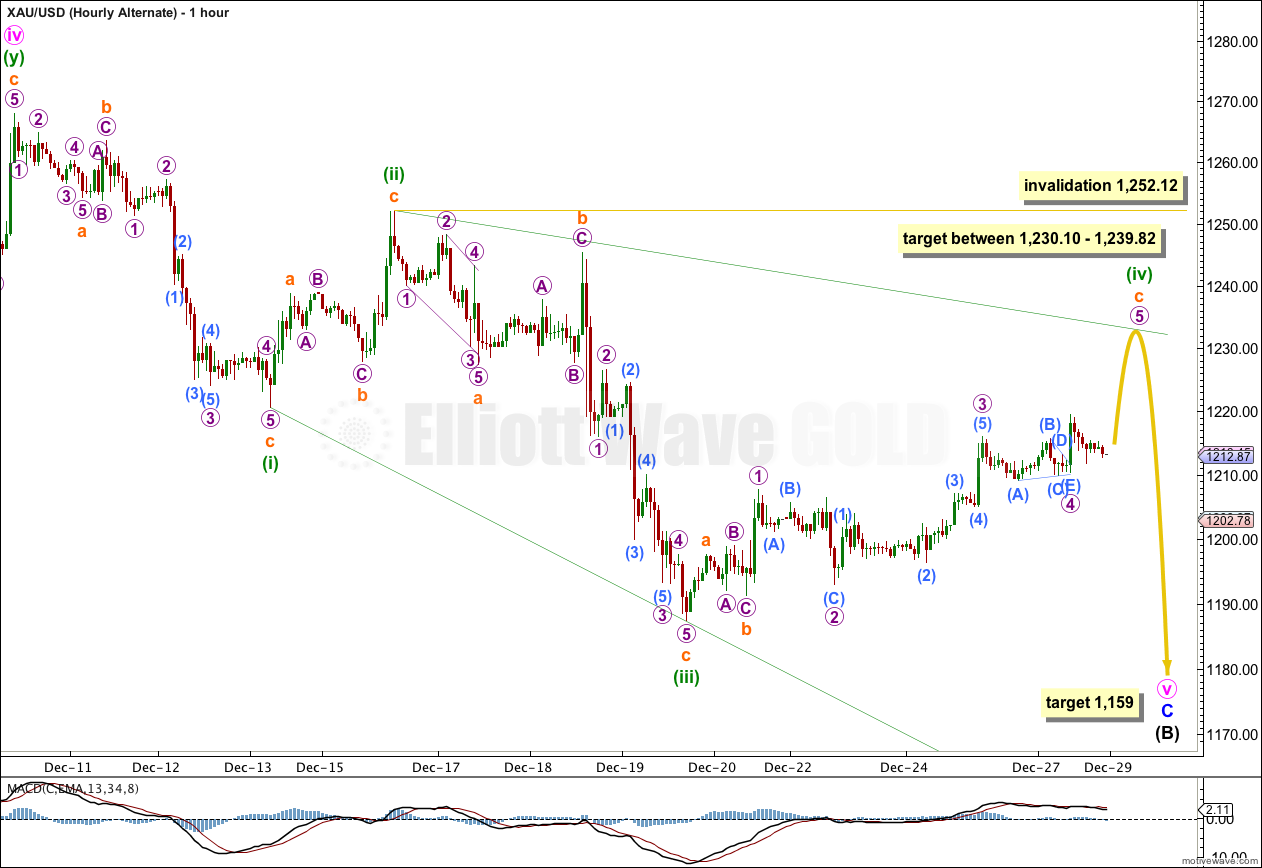Last analysis expected a fourth wave correction may have been complete. A trend channel was provided for confirmation. We did not get confirmation and price moved higher, remaining just below the invalidation point.
The wave count is mostly the same.
Click on the charts below to enlarge.
Gold is still within a large fourth wave correction at primary wave degree which is incomplete. To see a full explanation of my reasoning for expecting that primary wave 4 is not over and is continuing see this.
Primary wave 2 was a rare running flat correction, and was a deep 68% correction of primary wave 1. In order to show alternation in structure primary wave 4 may be a zigzag, double zigzag, combination, triangle or even an expanded or regular flat. We can rule out a zigzag because the first wave subdivides as a three. This still leaves several structural possibilities.
The downwards wave labeled intermediate wave (B) is now over 90% the length of the upwards wave labeled intermediate wave (A). Primary wave 4 may be a flat correction, but it may also still be a combination or triangle as there are still several different structural possibilities.
At 1,167.73 intermediate wave (B) would be 105% the length of intermediate wave (A), and primary wave 4 may be an expanded flat correction. Expanded flats normally have C waves which move substantially beyond the end of the A wave, and which are often 1.618 and sometimes 2.618 the length of the A wave. If 1,167.73 is reached and passed then the subsequent upwards wave for intermediate wave (C) may reach well above 1,433.83.
Within minor wave C there was no Fibonacci ratio between minute waves iii and i. This makes it more likely we shall see a Fibonacci ratio exhibited between minute wave v and either of i or iii. At 1,159 minute wave v would reach equality in length with minute wave iii. This lower target allows enough room for minute wave v to complete.
Downwards movement has breached the parallel channel drawn about intermediate wave (B) downwards, and it has found support at the next trend line.
Draw a parallel channel about minor wave C downwards with the first trend line from the highs labeled minute waves ii to iv, then place a parallel copy upon the low labeled minute wave iii. Downwards movement is finding support at the lower edge of this channel.
When the channel about intermediate wave (B) is finally breached by upwards movement then I would consider that final confirmation that intermediate wave (C) is underway.
Primary wave 4 may not move into primary wave 1 price territory. This wave count is invalidated with movement above 1,532.90.
Main Hourly Wave Count.
Minuette wave (iv) has moved higher, and we still do not have trend channel confirmation that it is over. There is almost no room left for upwards movement, and so it must be over if this wave count is correct.
At the daily chart level this main hourly wave count has a better look than the alternate below.
I want to see movement below the parallel channel containing minuette wave (iv) to have confidence that it is over. A full hourly candlestick below the channel and not touching the lower trend line would provide a clear channel breach.
While price remains within this channel the alternate hourly wave count below must be considered.
At 1,155 minuette wave (v) would reach equality in length with minuette wave (iii). This gives us a smaller $4 target zone.
Minuette wave (iv) may not move into minuette wave (i) price territory. This wave count is invalidated with movement above 1,220.65.
If this main hourly wave count is invalidated then the alternate hourly wave count below should be used.
Alternate Hourly Wave Count.
There are two structural possibilities for a fifth wave. The main hourly wave count above looks at the more common structure of an impulse for minute wave v, and this alternate looks at the less common structure of an ending diagonal.
At the daily chart level this alternate wave count does not have the right look; ending diagonals normally have very obvious zigzags for subwaves 1, 3 and 5. On the daily chart for this ending diagonal minuette waves (i) and (iii) look like impulses and do not look like zigzags.
Within an ending diagonal all the subwaves must subdivide as zigzags. Diagonals are the only structures where you will see a third wave labeled as a zigzag.
Within a diagonal the second and fourth waves most commonly end between 0.66 and 0.81 of the prior subwave. Within this possible diagonal minuette wave (ii) was a 0.66 correction of minuette wave (i). Minuette wave (iv) would be between 0.66 and 0.81 the length of minuette wave (iii) between 1,230.10 and 1,239.82.
This wave count eliminates the problem of proportions within minuette wave (iii); this downwards movement subdivides nicely as a zigzag.
Within minuette wave (iv) subminuette wave a is remarkably short, and this reduces the probability of this wave count slightly. However, a bigger problem is within the structure of subminuette wave c: micro wave 3 must subdivide as an impulse and the only way this works is to see submicro wave (1) ending at 1,201.74 so that submicro wave (3) is not the shortest wave. If submicro wave (1) ends there then on the five minute chart it does not subdivide into a five wave structure. I will allow for the possibility that my analysis of this piece of movement may be wrong.
Within the diagonal minuette wave (iv) must overlap into minuette wave (i) price territory; this wave count requires movement above 1,220.65.
Within the diagonal minuette wave (iv) may not move beyond the end of minuette wave (ii). This wave count is invalidated with movement above 1,252.12.
Alternate Daily Wave Count – Triangle.
It is also possible that primary wave 4 may continue as a regular contracting (or barrier) triangle.
A new low below 1,180.40 is also possible for this wave count if the triangle is a running triangle, as about 40% of triangles are.
The expected direction and structure of this next upwards wave is the same, but for this alternate intermediate wave (C) of the triangle may not move beyond the end of intermediate wave (A). The triangle is invalidated with movement above 1,438.83.
The final intermediate wave (E) upwards may not move above the end of intermediate wave (C) for both a contracting and barrier triangle. E waves most commonly end short of the A-C trend line.
All five subwaves of a triangle must divide into corrective structures. If this next upwards movement subdivides as a zigzag which does not make a new high above 1,438.83 then this alternate would be correct.
Triangles take up time and move price sideways. If primary wave 4 unfolds as a triangle then I would expect it to last months rather than weeks.




